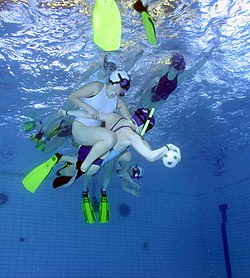Underwater rugby: Difference between revisions
reverting non-NPOV, uncited comment |
|||
| Line 33: | Line 33: | ||
== Federations == |
== Federations == |
||
Like [[underwater hockey]], underwater rugby is controlled by '''[[CMAS]]''', the World Underwater Federation |
Like [[underwater hockey]], underwater rugby is controlled by '''[[CMAS]]''', the World Underwater Federation. |
||
== See also == |
== See also == |
||
Revision as of 18:05, 3 May 2008
Underwater Rugby (UWR) is a quite young sport that has its origin in the physical fitness training of German diving clubs and has little in common with “normal” Rugby except for the name. It is played in a pool with a depth of 3.5m to 5m and the goals (heavy metal buckets with a diameter of about 40cm) are at the bottom of the pool. Two teams (blue and white), each with six players (plus five substitutes), try to score a goal by sending the slightly negatively buoyant ball (filled with saltwater) into the opponents’ goal. It is a fast and exhausting game therefore the subs replace their players on the fly.
The game always takes place under water and the ball must not leave the water. The ball can be passed (in any direction) to the other players. It “flies” about 2m or 3m before it stops due to the water resistance. This makes good tactics and good (three dimensional) positioning essential. The players can use different abilities. Strength, speed, mobility or simply low consumption of oxygen are all similarly important.
Not very many people play underwater rugby, because of this UWR is often played in mixed male-female teams.

History
Underwater Rugby was introduced in 1961 as a game, where a ball was used that has been filled with seawater. Ludwig von Bersuda was a member of the German Underwater Club of Cologne , who came up with the idea of a ball game underwater. At that time this game was used to warm-up before normal training. Franz Grimmeisen was a member of the German Underwater Club in Duisburg, a city nearby Cologne. He was ambitious to make a competitive sport from this ball game. The German Liveguard Association (DLRG) of Mülheim (DLRG Mülheim/Ruhr) had founded a diver's club, and through contact with members of DUC Duisburg learned of the underwater ball game that would in future become known as "Underwater Rugby". With the help of DLRG Mülheim (since 1967 TSC Mülheim/Ruhr), Franz Grimmeisen arranged the first Underwater Rugby game on Sunday October 4, It took place between DLRG Mülheim and DUC Duisburg. This match can be regarded as the first underwater ball game. A first championship was carried out 1966 in Mülheim, at that time with eight players per crew. 1971 was the year of the first all-German Underwater Rugby championship, which had at that time however still no official character. In 1973 Underwater Rugby was officially introduced. The first official European championship was carried out in the city of Malmø in Sweden. The first world championship took place 1980 in Mülheim/Ruhr, the birthplace of Underwater Rugby.
By February 2007 Underwater Rugby was introduced to the Philippines by Marius Bayer, a German trainee. Previously, a Filipino friend, Ryan Buaron who plays Underwater Hockey introduced Bayer to the UW Hockey. In return, Bayer invited the members of the Philippine Underwater Hockey Confederation to hold the first ever Underwater Rugby game in the Philippines and perhaps in Asia-Pacific.
Federations
Like underwater hockey, underwater rugby is controlled by CMAS, the World Underwater Federation.
See also
- More details are available in the German article
- Some information can also be found in Finnish
- A lot of underwater rugby information World Of Underwater Rugby
- Underwater Rugby at YouTube - background and rules (4' 30")
- Sportalsub http://www.sportalsub.net
